| Pages:
1
..
3
4
5
6
7
..
19 |
MrHomeScientist
International Hazard
    
Posts: 1806
Registered: 24-10-2010
Location: Flerovium
Member Is Offline
Mood: No Mood
|
|
Hah, well that would explain it then. My acetone has never stuck around long enough to form that layer  My products so far have only had the water and oil phases. Perhaps a scale-up is in order for this weekend! My products so far have only had the water and oil phases. Perhaps a scale-up is in order for this weekend!
I agree with you on testing it. The two tests we have aren't really definitive, though the scent is really promising. I don't have a hotplate that
will get hot enough to do the K-synth myself, sadly, so I'm out of luck on that for now. In the meantime I'll keep working on my terpineol. I know
you've made potassium before, so good luck when you try it with terpineol!
|
|
|
Eclectic
National Hazard
   
Posts: 899
Registered: 14-11-2004
Member Is Offline
Mood: Obsessive
|
|
"Citrusy" sounds like you are making limonene. Terpineol should smell like lilac or hyacynth. I'm having a go at using various acid catalysts to
make terpin hydrate, then dehydrate to terpineol. Will post if I get anything promising.
|
|
|
blogfast25
International Hazard
    
Posts: 10562
Registered: 3-2-2008
Location: Neverland
Member Is Offline
Mood: No Mood
|
|
Update:
What’s slightly worrying is that the test tube with the eight drops of ‘hydrated turpentine’ has now (overnight) gone as blue/green as the
controls. But it did take a much, much longer time to achieve full oxidation of the 1 mmol of dichromate contained in it.
But both products are remarkably similar bar a slight difference in colour. Both have been combined now and much anh. Mg2SO4 has been added for
drying. I might attempt a BP determination once it's dry...
Another observation I made was that the crude oily phase (just after refluxing) was really quite voluminous compared to what's left of it now. That
also happened in the first run. On neutralising and washing with water the volume of oily phase goes down very significantly. That suggest some water
soluble products have been leached out.
I'm also pretty convinced that alfa-repineol must indeed be acetone insoluble: it's too hydrocarbonish for the one hydroxyl group to make it
acetone soluble, IMHO.
|
|
|
blogfast25
International Hazard
    
Posts: 10562
Registered: 3-2-2008
Location: Neverland
Member Is Offline
Mood: No Mood
|
|
Quote: Originally posted by Eclectic  | | "Citrusy" sounds like you are making limonene. Terpineol should smell like lilac or hyacynth. I'm having a go at using various acid catalysts to
make terpin hydrate, then dehydrate to terpineol. Will post if I get anything promising. |
It has occurred to me. Limonene, itself a hydratable terpene, is listed in the original paper’s by-products. But alfa-terpineol is supposed to be
the main reaction product…
Not sure though what you mean by ‘dehydrating’ in this context.
Your help would certainly be appreciated.
There’s also the reaction of limonene (very OTC) with trichloroacetate to synth. the alfa-terpineol trichloroacetate that can be considered…
|
|
|
blogfast25
International Hazard
    
Posts: 10562
Registered: 3-2-2008
Location: Neverland
Member Is Offline
Mood: No Mood
|
|
http://www.scielo.br/scielo.php?script=sci_arttext&pid=S...
... for that reaction between limonene and trichloroacetic acid (courtesy of Eclectic, above).
[Edited on 3-4-2011 by blogfast25]
|
|
|
Eclectic
National Hazard
   
Posts: 899
Registered: 14-11-2004
Member Is Offline
Mood: Obsessive
|
|
I've found many references that indicate that both limonene and pinene will add water to form terpin hydrate with dilute mineral acids, and possibly
some alcohol to improve solution of H2O in the terpene phase.
Terpin Hydrate has low odor and can be isolated nicely crystalline. From there, boiling with dilute mineral acids removes water to form terpineol.
I'm thinking 1 cup turpentine, 1 cup 70% isopropanol (rubbing alcohol), and about a tsp (5ml) H2SO4. I'm also trying it with isopropanol/HCl, and
Methanol/H2SO4 (water 25-30%)
|
|
|
blogfast25
International Hazard
    
Posts: 10562
Registered: 3-2-2008
Location: Neverland
Member Is Offline
Mood: No Mood
|
|
Quote: Originally posted by Eclectic  | I've found many references that indicate that both limonene and pinene will add water to form terpin hydrate with dilute mineral acids, and possibly
some alcohol to improve solution of H2O in the terpene phase.
Terpin Hydrate has low odor and can be isolated nicely crystalline. From there, boiling with dilute mineral acids removes water to form terpineol.
I'm thinking 1 cup turpentine, 1 cup 70% isopropanol (rubbing alcohol), and about a tsp (5ml) H2SO4. I'm also trying it with isopropanol/HCl, and
Methanol/H2SO4 (water 25-30%)
|
Great! Could you post one or two of these references? Googling only points to medical info, not even what 'terpin hydrate really is'. If it can indeed
be crsytallised, that would be a great advantage for work up...
Edit:
Oh, I get you now: terpin hydrate:
http://drugstoremuseum.com/sections/level_info2.php?level_id...
I can see how that could be dehydrated to terpineol...
"In making terpin hydrate a mixture of four parts of rectified oil of turpentine, three parts of alcohol (sp. gr. 0.863), and one part of nitric
acid is put in large, shallow porcelain dishes and allowed to stand for three or four days. The crystals which have formed are then collected and
allowed to drain thoroughly; they are then pressed between sheets of absorbent paper, and recrystallized in a cold solution of 95 per cent, of
alcohol. The product is about 12 per cent, of the original turpentine oil. E. T. Hahn proposed the use of methyl alcohol (sp. gr. 0.801) in place of
alcohol, in making terpin hydrate. ( A. J. P., 1897, 73.) Terpin hydrate is officially described as in "colorless, lustrous, rhombic prisms, nearly
odorless, and having a slightly aromatic and somewhat bitter taste. Permanent in the air. Soluble in about 200 parts of water, and in 10 parts of
alcohol at 25° C. (77° F.); in 32 parts of boiling water, and in 2 parts of boiling alcohol; also soluble in about 100 parts of ether, 200 parts of
chloroform, or 1 part of boiling glacial acetic acid. Terpin Hydrate melts when quickly heated at 116° to 117° C. (240.8° to 242.6° F.), with the
loss of water, and, at the temperature of boiling water, sublimes in fine needles. When heated in a flask adapted for distillation, it first loses
water. At 258° C. (496.4° F.) anhydrous terpin distils over without decomposition, soon solidifying to a crystalline, hygroscopic mass, which melts
at 102° to 105° C. (215.6° to 221° F.). When strongly heated on platinum foil, it burns with a bright, smoky flame, leaving no residue. If to its
hot, aqueous solution a few drops of sulphuric acid be added, the liquid will become turbid and develop a strongly aromatic odor. Terpin Hy-drate
should not have the odor of turpentine, and its hot, aqueous solution should not redden blue litmus paper." U.S. The anhydrous terpin obtained from it
by the loss of water has the characters of a glycol. Dipentene dihydrochloride is its hydrochloric acid ether. By the loss of water the terpin then
becomes terpineol and finally yields dipentene, terpinene, or terpinolene, according to the conditions of its treatment. Bouchardat and Voiry obtained
terpineol in crystals which melt at 35° C. and remain in superfusion for long periods. (Ann. Ch. Ph., 1893, 103.) For Wallach's researches on
crys-tallized terpineol, see P. J., 1893, 2."
[Edited on 3-4-2011 by blogfast25]
|
|
|
MrHomeScientist
International Hazard
    
Posts: 1806
Registered: 24-10-2010
Location: Flerovium
Member Is Offline
Mood: No Mood
|
|
Today I did a run of the terpineol synthesis at 4x what I did before:
18.4mL turpentine
6.4mL H2SO4
100mL Acetone
I ran this for about 3 hours, with some strange results.
First, the initial mix was three layers, instead of the two I'd previously observed.
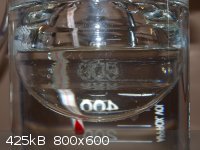
I set this one up with my new ground glass setup - a 250mL RBF in a hot water bath and a Liebig condenser connected to some cold water for the jacket.
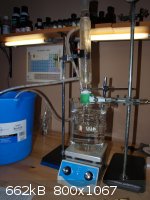
I ran this for 3 hours with the standard color change to yellow. The volume didn't change at all, so my condenser setup is working beautifully.
However, when I stopped the reaction and took everything apart, the product only had one layer!
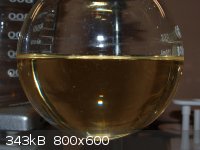
This was before neutralizing. Even after neutralizing there didn't appear to be any change. Actually I added the stoichiometric amount of base to
neutralize it, but it was still acidic. I decided to leave it to see if it does anything overnight. Blogfast, have you ever seen anything like this in
your trials? It seems my oil layer has disappeared, even though volume has not decreased. Maybe the large amounts I'm using require a longer time to
settle into layers? I'll check again tomorrow.
|
|
|
blogfast25
International Hazard
    
Posts: 10562
Registered: 3-2-2008
Location: Neverland
Member Is Offline
Mood: No Mood
|
|
MrHS:
Firstly, the three layers is bizarre. Are you sure the ratios used are these in the paper? 18.4 ml turps sounds mighty high for 100 ml acetone, off
the top of my head. And the H2SO4: was it 15 v/v% (if not you’ve no water in there!)
But the disappearance of the layers into 1 layer I think may be a good sign. Here’s why. What’s always bothered me is that in the paper
they claim to dilute their sample for analysis (taken every 30’, IIRW) with more acetone (after meutralisation), then directly inject it in their MS
and GC. Well, with what I saw that wouldn’t make any sense: you can’t reliable inject a two phase system into the evaporator of a MS or GC! That
would strongly point to the authors having obtained a single phase too, like you have. Sadly the point about the number of phases isn’t touched upon
in the paper.
Re. neutralisation: on both accounts I had the stoichiometric amount of NaOH at hand as NaOH 5%, on both accounts it turned out not to be enough! Like
you…
Re. work up: your new system seems more that robust enough to go for direct distillation: crank up the heat to 100 C and acetone should be coming over
swiftly (56 - 57 C). At some point though I’m sure the bottom will split up again. You could stop there and attempt liquid-liquid extraction with
water to get the last bit of acetone into the added water. Or you could attempt to distil till almost dry, then wash with water…
I’m convinced now that my product is too contaminated with limonene, as eclectic suggests: the smell is just too strong and not in accordance with
the literature described delicate lilac flagrance of terpineol.
With the new information about terpin hydrate it would appear that the conversion of alfa-pinene would be like this: alfa pinene > limonene >
terpin hydrate > alfa-terpineol. I think the last step in my case wasn’t completed.
Good work, MrHS!
%$%$%$%$%$%
Terpin Hydrate Synth:
I’ve also started an attempt to synth. terpin hydrate from turpentine using roughly the recipe above. It says ‘nitric acid’ but indicates no
strength. Instead I’ve used 50 v/v% H2SO4 because I can’t really see how this hydration can be achieved without some water present (alcohol being
a poor hydration agent). I used:
80 ml straight turps
60 ml alcohol (well, ‘methylated spirits’)
20 ml H2SO4 50/50 v%
.. so 160 ml total volume, poured out in a clean 1 L PE ice cream tub, so that maximum contact area between the two phases exists. Patience is a
virtue...
I imagine the reaction to go as:
Alfa pinene (l) < === > limonene (l) (isomerisation)
Limonene (l) === > terpin hydrate (cr) (hydration), catalysed by acid.
… with the first reaction being ‘pulled’ to the right by the second.
The hydration itself, say for instance on the dangling methyl ethenyl group, I imagine to go as follows. Electrophylic attack by a proton on the
ethenyl double bond, turning the =CH2 group into a -CH3 group and the tertiary carbon into a carbenium ion. Water then approaches the carbenium ion
with its partially negatively charged O atom, leaving behind an OH group on the tertiary carbon and freeing a proton (thus showing the acid is indeed
catalytic and isn’t used up). Similar for the hexene double bond and its tertiary carbon in position 1.
Eclectic is right: there are quite a few references to terpin hydrate, many short on details though. Here’s a google book reference:
http://books.google.co.uk/books?id=07g30rxCA0EC&pg=PA495...
… which suggests stirring turpentine wik 2 -3 times its volume of 30 % H2SO4 at RT for 4 - 6 day to get the hydrate.
So I’ve initiated another test of 56 ml turps + 72 ml water and 32 ml of conc. H2SO4 (total = 160 ml) into the same type of ice cream 1 L container.
I’ll stir it regularly but I reckon the large contact area between the phases and enough time should make the reaction happen, provided the turps
contain enough alfa pinene.
Update:
Eclectic is right: there are quite a few references to terpin hydrate, many short on details though. Here’s a google book reference:
http://books.google.co.uk/books?id=07g30rxCA0EC&pg=PA495...
… which suggests stirring turpentine wik 2 -3 times its volume of 30 % H2SO4 at RT for 4 - 6 day to get the hydrate.
So I’ve initiated another test of 56 ml turps + 72 ml water and 32 ml of conc. H2SO4 (total = 160 ml) into the same type of ice cream 1 L container.
I’ll stir it regularly but I reckon the large contact area between the phases and enough time should make the reaction happen, provided the turps
contain enough alfa pinene.
[Edited on 4-4-2011 by blogfast25]
|
|
|
MrHomeScientist
International Hazard
    
Posts: 1806
Registered: 24-10-2010
Location: Flerovium
Member Is Offline
Mood: No Mood
|
|
Blogfast:
Thanks for the encouragement! The ratios should be the same, I just multiplied everything from my initial run by 4. My first post used 4g turpentine,
which came out to 4.6mL so I just used 4x that volume in this one (along with 4x acetone and H2SO4 volumes). My H2SO4 is 4.4M, so about 20%
concentrated. It's battery electrolyte from the local Sears auto shop. I adjusted the volume so there's the same amount of acid in the mix, of course,
but I guess a little less water.
You comment on the single phase is interesting. It's strange that it would appear in this one run and not any of the others. Mine unfortunately still
smells of turpentine though :/ I never have gotten that pleasant scent you've described.
----
I neutralized my products tonight, and ended up having to use almost twice as much NaOH as I stoichiometrically should have. Ah well. The color
changed a bit, becoming more of a cloudy yellow. A new phase has appeared at the bottom, which is the water from my NaOH solution. You can sort of see
it in this picture.
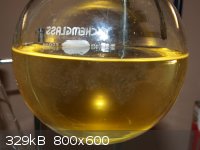
I decanted it off into a sep funnel (another of my new glassware pieces I was excited to use), and you can see the aqueous layer clearly on the
bottom. The line in the middle isn't another layer, just some crap on the inside of the funnel that I can't get off until I get a proper bottle brush.
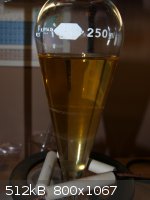
Like you did, I also found some sodium sulfate crystals that formed from the neutralization, leftover in the reaction flask. Hopefully no more will
form in the funnel and cause that nuisance you mentioned!
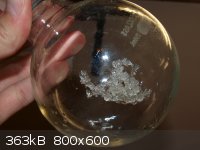
I suppose the next step, then, is to boil off the acetone and see what I'm left with of my upper layer. It's strange that it's not already in a
separate oil layer though, as I thought it wasn't soluble in acetone. Turpentine certainly wasn't.
Good luck with your terpin hydrate synthesis! That'd make a pretty simple alternative route, if a bit slower. The fact that it crystallizes would be
great to ensure you're getting what you want, rather than the soup that the reflux method ends up with.
[Edited on 4-5-2011 by MrHomeScientist]
|
|
|
blogfast25
International Hazard
    
Posts: 10562
Registered: 3-2-2008
Location: Neverland
Member Is Offline
Mood: No Mood
|
|
MrHomeScientist:
It remains strange that you don’t get that characteristic smell that I get. No idea how to explain that. But go right ahead with the distillation
and see what you obtain. More transformations may take place during the distillation process…
I’ve made some strange observations in the mean time.
When I started the second run at terpin hydrate, the one that called for turps + 30% H2SO4, I was a little careless and got a curious little side
show.
I measured the turps in a 100 ml PP measuring cylinder, emptied it into the ice cream tub, then measured the water (w/o cleaning the measuring
cylinder), added it to the turps and the finally measured the conc. H2SO4 (w/o cleaning the measuring cylinder) and added it to the turps/water
mixture. Well, well: on measuring the H2SO4 the remains on the measuring cylinder (MC) underwent a marked colour change to almost red! It needs to be
said that my ‘Knockout Drain Cleaner!’ sulphuric acid is 94.5 w% H2SO4 (titrated) but slightly amber in colour to begin with.
I then filled up the MC with water for a soak and didn’t think much more about it. Until I washed up my stuff for the day: the MC had a white
substance (the red had gone by then) on its walls and it was clearly water insoluble (and quite hard to remove too) Well, terpin hydrate is almost
water insoluble and this resource:
http://drugstoremuseum.com/sections/level_info2.php?level_id...
… claims:
”Terpin hydrate may be identified by the color reaction of Petenkoefer. A drop of sulfuric acid is added to a crystal of terpin hydrate. This
produces a yellow color which changes to orange on heating. If a solution of levulose, 0.5 Gm. in 100 cc. of 25 per cent alcohol, is added a carmine
red color develops. {Bull. Soc. Pharm. Bordeaux, 1922, 60, 49.)”
(levulose is fructose, BTW. Very OTC.)
Well, my solution had of course heated up a bit due to the solvation of the conc. H2SO4. All seems to fit the formation of a bit of terpin hydrate.
Today I replicated the observation, first with a glass test tube but that didn’t work too well because the turps don’t cling to glass much
(surface tension). But using a small PP MC, I got the same phenomenon alright. And adding some water to the emptied MC, the red colour disappeared and
a strong milkyness appeared, I’m sure it’s a suspension and not an emulsion. It’s been transferred to a test tube for possible decantation later
on and maybe checking alcohol solubility or repeating the ‘Petenkoefer test’ (with fructose).
$%$%$%$%$
On the terpineol front, I’ve left my reaction product (from the 2 runs combined) with a good dollop of anh. MgSO4 to dry for a few days and obtained
6 ml of a pale yellow, oily citrussy liquid. Like eclectic I believe it contains too much limonene to be considered alfa-terpineol. The limonene may
also be responsible for the positive test with K2Cr2O7.
To test that hypothesis, the product is now being treated with 30% H2SO4, at RT in a shallow plastic dish. If limonene can be hydrated to terpin
hydrate over the course of the next days the citrussy odour should disappear 9and crystals should appear): terpin hydrate is almost odourless,
apparently…
On a side note: having by now read and learned a lot about terpene chemistry, you could safely call turpentine ’Evidence of
Evolution in a Bottle’!, because it’s amazing how many of these very similar derivatives (also carveol, carvone etc) are found in so many,
often quite disparate plant species and essential oils derived from them!
Even tetrahydro myrcenol, another t-alcohol with that 2-methyl-2-ol structure, typical of t-butanol and t-amyl alcohol (the two
t-alcohols that work for K synth) that has been discussed above as a possible candidate for K/Na catalysis, seem structurally related to
alfa-terpineol:
http://www.iff.com/Ingredients.nsf/0/D40CD91FB557A2B78025699...
TH myrcenol wouild have been one of my first choices to test as a catalyst but despite its widespread use in flagrant OTC applications, it's
remarkably hard to get hold of...
%$%$%$%$%
And here’s another claimed method for the synth. of alfa-terpineol, this onr from limonene:
http://chestofbooks.com/health/aromatherapy/The-Volatile-Oil...
When perfectly dry, limonene absorbs one molecule of hydrohalogen with the formation of limonene monochlorhydrate which, when treated with sodium
acetate, yields active a-terpineol.
[Edited on 5-4-2011 by blogfast25]
|
|
|
Eclectic
National Hazard
   
Posts: 899
Registered: 14-11-2004
Member Is Offline
Mood: Obsessive
|
|
http://www.sciencemadness.org/talk/viewthread.php?tid=15455&...
Terpine chemistry makes my head hurt. I suspect production of terpin hydrate is driven by the product crystallizing out of solution of equilibrating
products.
|
|
|
blogfast25
International Hazard
    
Posts: 10562
Registered: 3-2-2008
Location: Neverland
Member Is Offline
Mood: No Mood
|
|
Eclectic:
I get a
Error
Sorry, you are not permitted to view this forum
... message when clicking that link. Have you got the correct url there?
|
|
|
Polverone
Now celebrating 21 years of madness
        
Posts: 3186
Registered: 19-5-2002
Location: The Sunny Pacific Northwest
Member Is Offline
Mood: Waiting for spring
|
|
Quote: Originally posted by blogfast25  |
Eclectic:
I get a
Error
Sorry, you are not permitted to view this forum
... message when clicking that link. Have you got the correct url there?
|
That's a link to a thread in References. I have given you access to that subforum now. If you normally use the /whisper/ site you will need to log in
separately for /talk/ links to protected subforums.
PGP Key and corresponding e-mail address
|
|
|
blogfast25
International Hazard
    
Posts: 10562
Registered: 3-2-2008
Location: Neverland
Member Is Offline
Mood: No Mood
|
|
Polverone:
Yes, it works now, thanks!
|
|
|
blogfast25
International Hazard
    
Posts: 10562
Registered: 3-2-2008
Location: Neverland
Member Is Offline
Mood: No Mood
|
|
Both papers are interesting. The first part’s conclusions run very similar to those of the paper (above) MrHomeScientist and me did some experiments
with: alfa-pinene gets converted to alfa-terpineol, limonene and some other by-products, catalysed by a strong acid and in the presence of water at 70
- 80 C. It shows also how the ratios of the product mix vary with experimental conditions. This variability is a limitation for those who can’t
afford a rectification to isolate the alfa-terpineol as a reasonably pure substance.
The route of hydrating pinene to terpin hydrate crystals (which can at least be isolated easily) at RT, followed by dehydration to mainly
alfa-terpineol seems more attractive in that sense. But the three experiments that I’m running for terpin hydrate are now in their sixth day have
yet to yield the first crystal…
I’ve a feeling that I’ll end up using the ‘Spanish method’: esterification of limonene (readily available - eBay) with trichloro acetic acid,
followed by alkaline de-esterification to alfa-terpineol (extraction with hexane)… 
|
|
|
Eclectic
National Hazard
   
Posts: 899
Registered: 14-11-2004
Member Is Offline
Mood: Obsessive
|
|
Careful with the Trichloroacetic...it causes liver tumors. But I'm tempted by that route also. It's a shame trifluoroacetic is so expensive. I also
have yet to see any Terpin Hydrate, using isopropanol and 5% H2SO4. I may separate the top organics layer from my 4 different batches and use just
10-20% H2SO4 with a mag stirrer and bar. It may be that the current source of turpentine is byproduct of sulfite process papermaking and is not as
good a source of pinene as distillation from pine resin.
I'll also try terpin hydrate from limonene.
http://www.greenterpene.com/
[Edited on 4-10-2011 by Eclectic]
|
|
|
blogfast25
International Hazard
    
Posts: 10562
Registered: 3-2-2008
Location: Neverland
Member Is Offline
Mood: No Mood
|
|
Your mention of ‘sulfite process’ rings a bell: the very first paper on hydration of pinenes was actually mentioned ‘sulphate
turpentine’. A typo? But they got comparable results with that kind of turps as with pure pinene…
So you’re not getting any terpin hydrate crystals either, huh? Even my experiment with just turps + dilute H2SO4 (no solvent) isn’t working so far
(a week now) but I’ll give it more time.
One possibility is to get some ‘essential pine oil’, that might be higher in pinenes but they tend to be expensive and it’s impossible to tell
whether in this ‘New Age’ world of ‘aromatherapy’ and assorted nonsense these products has been adulterated for profit or not… But I might
try that.
Thanks for the link and the health warning on TCAA. And they use that stuff for chemical peels!
It’s not only expensive; it’s also hard to get, at least anhydrous. And I don’t see an easy way to extract it from a watery solution…
Neutralise with Ca(OH)2 to Ca(TCA)2, crystallise and treat with an equivalent amount of conc. H2SO4 to displace the acid? Sounds messy!
|
|
|
Eclectic
National Hazard
   
Posts: 899
Registered: 14-11-2004
Member Is Offline
Mood: Obsessive
|
|
You may be able to make it from hexachloroethane by refluxing with 25% H2SO4, and maybe some iron.
I have 3-4 gallons of Freon 113 I stashed away 20 years ago...If it has not evaporated, conversion to 1,1,1,trifluoro-2,2,2,trichloroethane and
hydrolysis to trifluoroacetic acid is looking very worthwhile.
[Edited on 4-11-2011 by Eclectic]
|
|
|
blogfast25
International Hazard
    
Posts: 10562
Registered: 3-2-2008
Location: Neverland
Member Is Offline
Mood: No Mood
|
|
Hmm… that sounds like a lot of messing, assuming you’ve got any Freon left, of course. And how would you go about isomerising it?
But I imagine trichloroacetic acid may not be too hard to get in the US. eBay.co.uk sellers of watery solutions (for chemical peels) are
mainly US sellers (but all are watery solutions and laced with lactic/salicylic acids).
|
|
|
blogfast25
International Hazard
    
Posts: 10562
Registered: 3-2-2008
Location: Neverland
Member Is Offline
Mood: No Mood
|
|
Holy moly:
Scavenging through the Kremer Pigmente site (the guys most of us in Europe got their Shellsol D for K synth. from!) for some solvents, there’s
terpineol:
http://www.kremer-pigmente.de/shopint/index.php?cat=0301&...
Clicking through to ‘Details’, this looks like the real deal: 62.3 % α-terpineol, terpineol (total) > 98 %...
[Edited on 11-4-2011 by blogfast25]
|
|
|
Eclectic
National Hazard
   
Posts: 899
Registered: 14-11-2004
Member Is Offline
Mood: Obsessive
|
|
Well, hell, Blogfast, if all you want is to buy it, I don't even want to know you :-D (reference to "The West Wing" TV show).
I have 2 liters of Tert-Amyl alcohol and could send you some.
I'm kinda pissed off USA site doesn't offer it.
[Edited on 4-11-2011 by Eclectic]
|
|
|
MrHomeScientist
International Hazard
    
Posts: 1806
Registered: 24-10-2010
Location: Flerovium
Member Is Offline
Mood: No Mood
|
|
Yeah I've had a lot of trouble finding a source for a useable alcohol for the K-synth here in the US. That's why I'm interested in this whole
terpineol synthesis (plus it's a pretty neat process).
I haven't gotten much work done on it lately though, because I've been rather busy with stuff at work. I'm co-starring in an educational outreach
program that takes science demonstrations to local elementary schools, to get kids interested in science at an early age. This month is full of shows,
so that's taking up much of my time. It's lots of fun!
I'll see if I can't distill my latest product (as mentioned in my last post) this weekend.
|
|
|
blogfast25
International Hazard
    
Posts: 10562
Registered: 3-2-2008
Location: Neverland
Member Is Offline
Mood: No Mood
|
|
Quote: Originally posted by Eclectic  | Well, hell, Blogfast, if all you want is to buy it, I don't even want to know you :-D (reference to "The West Wing" TV show).
I have 2 liters of Tert-Amyl alcohol and could send you some.
I'm kinda pissed off USA site doesn't offer it.
[Edited on 4-11-2011 by Eclectic] |
No, no, no, Eclectic, of course I want to be able to synth. it but please do remember the purpose of this thread: to find other t-alcohols that could
work for the reduction of KOH with Mg and in particular for the synth. of Na by the same process (it’s suspected that poor
solubility of the alkoxides of Na and t-butanol and t-amyl alcohol in high alkanes is the problem).
In an ideal world where sourcing wasn’t a problem I would have tested maybe up to ten such alcohols by now but getting hold of the ones of interest
has proved difficult, hence the look out for stuff that can possibly be home synthesised, like alfa-terpineol.
There’s also tetrahydro myrcenol (2,6 dimethyl octan-2-ol) I find very hard to get, despite it being widely used in OTC flagrance systems (plenty of
patents on ‘bleach resistant perfumes’ out there - LOL)
And this one we thought would cure all our woes (US only)(courtesy Unintentional Chaos):
http://www.newdirectionsaromatics.com/dimethyl-benzyl-carbin...
… but Nurdrage wanted to get it and there was a long backlog (or something like that anyway). It got a bit forgotten after that. Shame, because
it’s a 2-methyl-2-ol type alcohol too…
I do have some t-amyl alcohol and it’s the one I use for K (but Nurdrage tested it for Na and it didn’t work).
How about we swap? 0.5 l of your t-amyl alcohol for 0.5 l of terpineol? Or another type of swap even? I’ll be ordering it this afternoon. Even if we
do get to synth. it, it’d be nice to have a baseline. Also, using the TCA or TFA route with limonene, it’s likely to be very expensive compared to
commercially available product. The TCA here is about £10 for (pure) 25 g TCA. And it’s basically non-recoverable…
Enjoy the shows, MrHomeScientist!
|
|
|
blogfast25
International Hazard
    
Posts: 10562
Registered: 3-2-2008
Location: Neverland
Member Is Offline
Mood: No Mood
|
|
Well over two weeks now and still no terpin hydrate crystals at RT. The mixtures (all three of them) have clearly darkened somewhat but that's about
it.
|
|
|
| Pages:
1
..
3
4
5
6
7
..
19 |